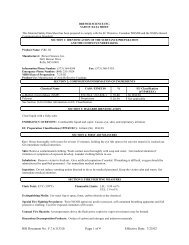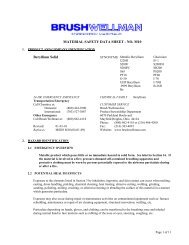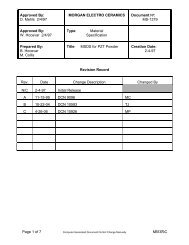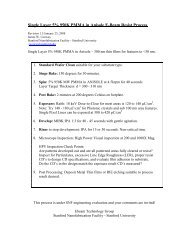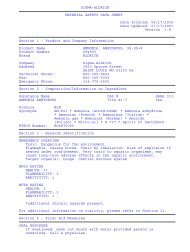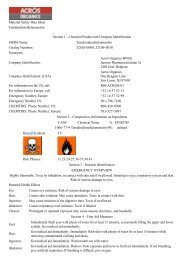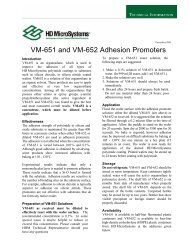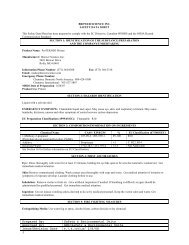DOW CORNING CORPORATION Material Safety Data Sheet DOW CORNING(R ...
DOW CORNING CORPORATION Material Safety Data Sheet DOW CORNING(R ...
DOW CORNING CORPORATION Material Safety Data Sheet DOW CORNING(R ...
You also want an ePaper? Increase the reach of your titles
YUMPU automatically turns print PDFs into web optimized ePapers that Google loves.
Inhalation:<br />
Oral:<br />
<strong>DOW</strong> <strong>CORNING</strong> <strong>CORPORATION</strong><br />
<strong>Material</strong> <strong>Safety</strong> <strong>Data</strong> <strong>Sheet</strong><br />
Page: 2 of 8<br />
Version: 1.1<br />
Revision Date: 2005/11/04<br />
<strong>DOW</strong> <strong>CORNING</strong>(R) XR-1541 E-BEAM RESIST IN MIBK DEV SAMPLE<br />
Signs and Symptoms of Overexposure<br />
No known applicable information.<br />
Medical Conditions Aggravated by Exposure<br />
No known applicable information.<br />
Overexposure by inhalation may injure the following organ(s): Lungs. Nervous system.<br />
Kidneys. Liver.<br />
Repeated ingestion or swallowing large amounts may injure internally.<br />
The above listed potential effects of overexposure are based on actual data, results of studies performed upon similar compositions,<br />
component data and/or expert review of the product. Please refer to Section 11 for the detailed toxicology information.<br />
4. FIRST AID MEASURES<br />
Eye:<br />
Immediately flush with water for 15 minutes. Get medical attention.<br />
Skin: Remove from skin and wash thoroughly with soap and water or waterless cleanser. Get<br />
medical attention if irritation or other ill effects develop or persist.<br />
Inhalation: Remove to fresh air. Get medical attention if ill effects persist.<br />
Oral: Get immediate medical attention. Only induce vomiting at the instructions of a physician.<br />
Never give anything by mouth to an unconscious person.<br />
Comments: Treat according to person's condition and specifics of exposure.<br />
5. FIRE FIGHTING MEASURES<br />
Flash Point:<br />
Autoignition Temperature:<br />
Flammability Limits in Air:<br />
Extinguishing Media:<br />
Fire Fighting Measures:<br />
Unusual Fire Hazards:<br />
62.6 °F / 17 °C (Closed Cup)<br />
Not determined.<br />
Not determined.<br />
Hazardous Decomposition Products<br />
On large fires use dry chemical, foam or water spray. On small fires use carbon dioxide<br />
(CO2), dry chemical or water spray. Water can be used to cool fire exposed containers.<br />
Self-contained breathing apparatus and protective clothing should be worn in fighting large<br />
fires involving chemicals. Determine the need to evacuate or isolate the area according to<br />
your local emergency plan. Use water spray to keep fire exposed containers cool.<br />
Vapors are heavier than air and may travel to a source of ignition and flash back. Static<br />
electricity will accumulate and may ignite vapors. Prevent a possible fire hazard by bonding<br />
and grounding or inert gas purge.



